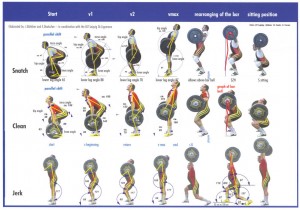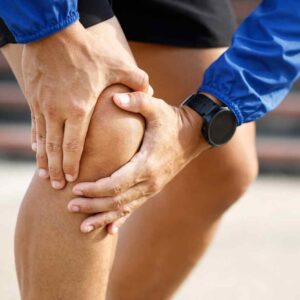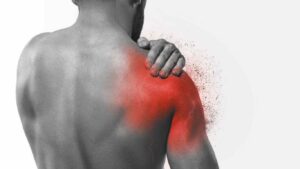Common Injuries that occur in Olympic Weightlifting Training & Competition
Words by GCPSH Physio Leigh McCarthy
 What is Olympic Lifting and Why should I consider doing it?
What is Olympic Lifting and Why should I consider doing it?
Olympic Weightlifting is a sport in which athletes compete to lift the greatest amount of weight overhead within an athlete’s weight category. The competition lifts are the Snatch and the Clean & Jerk. Each weightlifter receives three attempts in each lift. The sport of Olympic weightlifting is one in which maximal strength and power outputs are combined with flexibility to lift large weights from the ground to overhead which is a very challenging activity. Due to the complexity of movement and the amount/type of training needed to perform these lifts well, the body needs to be able to withstand extreme amounts of load in both the amount of weight lifted and the time spent training.
In contrast, Olympic-style Weightlifting is a form of weight training incorporating the competitive lifts above or variations of the Olympic weightlifts. Athletes use Olympic-style weightlifting as a part of their sports conditioning program to develop explosive speed strength, or power and this type of training can benefit almost all athletes, even children and older athletes. All the Olympic Athletes on the GC will use some form of Olympic-style weightlifting training in their strength & conditioning program at various phases in their preparation. GCPSH Olympic Athlete Dani Samuels, who finished 4th in the Womens Discus in Rio Olympics regularly trains at Gold Coast Weightlifting Club as part of her preparation.
Olympic weightlifting is safe, with lower injury rates than collision sports (Rugby Union, Rugby League and AFL), as well as other contact sports (soccer, basketball). In saying this, there are some common injuries that should be monitored when participating in this sport. The most common injuries in Olympic weightlifting would be classed as overuse injuries, which are sustained via repetitive actions over a prolonged period of time or from poor repeated technique.
Below are 2 common overuse injuries related to Olympic weightlifting and some management strategies to help manage and prevent them:
 1. Patellofemoral (Knee) Pain Syndrome
1. Patellofemoral (Knee) Pain Syndrome
Patellofemoral pain syndrome (PFPS) is the one of the most common causes of knee pain, with the injury having an especially high prevalence in a weightlifting population. PFPS is felt as pain at the front of the knee, or around the knee cap, which comes on over a prolonged period of time. Individuals with PSPS will complain of pain that begins with heavy squats or squat based movements (clean and snatch progressions). However, as the condition progresses the knee pain will occur with less weight/load and eventually interrupt daily activities such as walking up and down stairs and prolonged sitting.
PFPS is a multifactorial injury in which the structure of the knee, relative strength of the inner quadriceps muscle and hip stability and strength all play a role in causing pain. Common treatments for this condition include strengthening the inner quadriceps muscle known as the VMO, ensuring that the glutes are strong and playing a significant role in squat movements, making sure that the lateral thigh muscle and band (ITB) have sufficient length and finally that squat mechanics are corrected should any flaws be seen. Foam rolling of the lateral thigh and hip along with light quadriceps stretches can be started for the individual suffering from PFPS to help allay the symptoms. However, unless load through the knee is monitored, through technique correction and specific strength exercises the knee pain related to PFPS is likely to hang around and possibly worsen.
For more information read our other Article here
 2. Shoulder Impingement Pain
2. Shoulder Impingement Pain
Shoulder pain can be a problem in all overhead athletes, with shoulder impingement being a common cause of symptoms. Weightlifters are considered Overhead Athletes as they are required to move weights above shoulder height. The shoulder impingement may become painful after a single lift, or single heavy or high load session, or it may come on over a period of weeks or months. Shoulder impingement is usually felt as a pain in the front or top of the shoulder when performing overhead tasks (snatch, jerk, strict press, push press etc.), but can quickly development into pain with everyday activities such as reaching for objects on high shelves or laying on the affected side.
The injury is related to a narrowing of the space for the supraspinatus tendon (rotator cuff muscle) to pass through to attach to the arm, and/or an inflamed bursa (fluid filled sac used for lubrication within the body). Whatever the cause of the symptoms, there are usually a multitude of contributing factors, ranging from poor shoulder blade control while the arm is overhead, a decrease in rotator cuff strength and decrease in length of muscles surrounding the shoulder, back and chest.
Treatments for this injury include stretching of the pectoralis and latissimus muscles, rotator cuff strength through the entire range of movement of the shoulder and improving shoulder blade biomechanics while overhead. For individuals having troubles with overhead activities, try foam rolling and stretching the lats, using a trigger ball in the pec muscles as well as stretching them and starting some gentle rotator cuff strength. If the pain begins to interrupt daily activities, a change in overhead load may be necessary to prevent further injury and pain and should be guided by Coach and Physio.
With consultation with a coach and good management strategies, shoulder pain with overhead activities may be averted. It is essential to remember that symptoms stemming from overuse injuries may begin after a specific training event or become apparent after a prolonged period of time. There is usually a pattern to symptom occurrence and production, with an increase in training load, volume or intensity, coupled with poor technique being the main culprit. If symptoms persist after consulting your coach on technical faults and relative training modification it would be wise to seek the input of a physiotherapist who understands the complexity of weightlifting. Early detection, diagnosis and management are the keys to keeping training when pain occurs.
How to Reduce Your Risk of Injury
Injuries related to Olympic Weightlifting Training can be minimised with smart training prescribed by a Qualified Coach and very specific technique practices.
To achieve good lifting technique requires flexibility and mobility in a number of areas. At GCPSH we have Physio’s with a special interest in Olympic Lifting technique and they can work with you and your coach to Assess, or Screen, your flexibility/ mobility / control and help you identify your body area’s that need improving to reduce your risk of injury from Olympic Lift Training:
Sarah Bombell at our Burleigh Clinic has also completed her Level 1 Strength & Conditioning for Physiotherapists course and uses Lifting training to maintain her strength since her retirement from Australia’s Synchronised Swimming Team after London Olympics.
Phone 07 5500 6470 for an appointment or Book Online to be screened for flexibility, or to have your stiffness or pain assessed today.

































